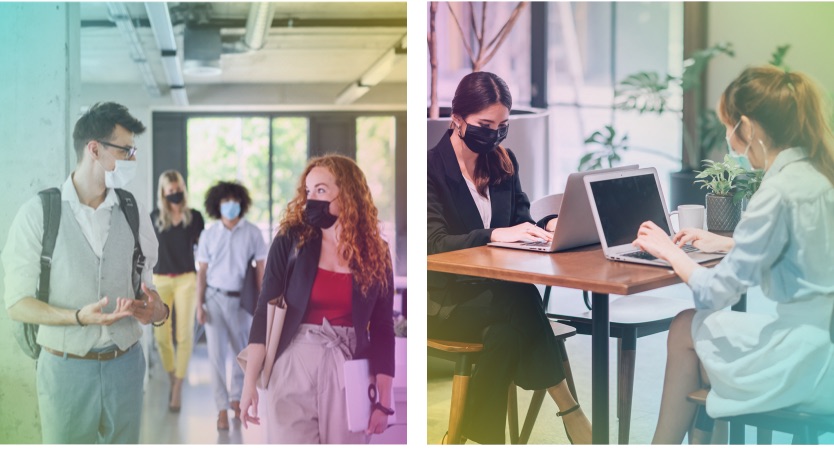
HOW WOULD THE POST-PANDEMIC OFFICE LOOK LIKE?
In mid-May 2020, Twitter made headlines becoming the first major company amid the COVID-19 pandemic to grant its employees the right to work from home — forever. No individual will be required to return, even after the health emergency is over.
The global lockdown turned out to be the most ambitious experiment with remote working in the history of humanity. Twitter's announcement amplified cries that the pandemic will eventually result in the death of the office itself. But is that really the case?

As it turns out, the same prediction had been made long before the coronavirus outbreak. About fifty years ago, urban theorist Melvin Webber proclaimed that "for the first time in history, it might be possible to locate on a mountain top and to maintain intimate, real-time, and realistic contact". Half a century later, the prophecy has come true. Social distancing has finally forced us to climb up to the peak.
Except that we do not believe offices will be — or should be — wiped out. Data from a research run at M.I.T., both before and during the pandemic, signal to us that something goes missing when our lives are dominated by virtual interactions. Under remote working, our personal networks begin to thin out, and we suffer from increasing social impoverishment with the passage of time.
What has endured the most damage are the weaker connections beyond our immediate circles. "The strength of weak ties", a theory formulated by sociologist Mark Granovetter in 1973, is crucial in understanding how ideas are spread and communities are born across large groups. Apart from the strong ties we maintain with friends, colleagues, and family members, we also form weak ties — relationships with casual acquaintances.

— or should be — wiped out

Strong ties yield dense, overlapping networks; your close friends are often close friends with each other. But our weak ties are in many situations even more important, because they connect us to a far broader range of people and completely separate social circles (or "bubbles", to say it in more Internet-friendly terms). Those individuals are more likely to introduce you to new ideas, challenge your preconceptions, and make you aware of the world outside your strong ties. They help us find job opportunities and adapt to new innovations. To put it simply, weak ties are the glue that hold us together as a broader community.
At M.I.T. we have been studying how pandemic homeworking is affecting the formation of weak ties. Using anonymous data on from the Institute's email servers, we are seeing that students, professors, and administrators are exchanging more messages with a smaller group of people. To project this finding to the wider society, we know that during the lockdowns of 2020 we have dedicated more time to our families at home and to our close friends on FaceTime, Skype or Whatsapp. In that same period, our acquaintances have slipped through the cracks.


The above results are preliminary and will be have to be validated through peer review. As our endless Zoom calls persist, we are beginning to get more insights on what such shift of social relations engenders, and there are enough to enunciate some hypotheses. One consequence of online socialization could be political polarization. Granovetter posited that weak ties in the physical world are indispensable to a healthy civic life. They are the key agent to maintain trust, enthusiasm, and mutual understanding among people of different beliefs. In contrast, the Internet allows us to cherry-pick what to see and whom to talk to, a habit only fueled by the digital algorithms that reinforce our connections with those who most agree with us. Needless to say, in shared offices or on sidewalks, we can't just click on a filter and screen out the weak ties. Those are the occasions that promote in-person contacts invaluable to a strong society.
If this is the case, it would be important to return to the old office, and refining that space to enhance our cohesion with one another. These changes were already in motion, as the 21st-century innovations of Silicon Valley campuses and co-working spaces ushered out the isolated cubicle, famously mocked by Jacques Tati in his 1967 film, Playtime.
Transformation of traditional floor plans into more open, dynamic spaces encourages the flow of ideas and social relations. Researchers call it the "cafeteria effect": when people have lunch together, weak ties are effortlessly established.

Moving towards the urban space, its density and diversity offer a richer variety of weak ties than any other given place. In the months ahead, we should probably expand our physical work lives beyond a rigid nine-to-five schedule and a single building — be it our living room or our old office desk. When the pandemic ends, and every library, park, and café reopen their doors again, we should start to look at alternatives to the traditional workplace. Technology has given us the liberty to work from home, it also empowers us to work from many places. To this end, we propose a multimodal work life, aimed at fostering weak ties, to revitalize our social and intellectual fabric.
In the meanwhile, things might be more nuanced. Those beneficial weak ties that facilitate the cross-pollination of ideas in normal times are also lethal in spreading COVID-19. Interaction with casual acquaintances had to come to a pause to minimize the channels of infection. In fact, the modelling of spreading diseases or spreading ideas on networks is mathematically very similar. Social distancing, which reduced inter-personal communications to only essential contacts, block us from receiving those meaningful, life-enriching ideas. As much potential as there is to meet new people and build healthy relations with them, the physical world is still more well-suited to the cultivation of weak ties. With our lockdown orders slowly being lifted, it is more important than ever to patch up those broken networks of weak ties.
We are not sure how many businesses will follow the example set by Twitter; what is certain is the fact that offices will no longer be the same. It could work in our favor if we give more thoughts to the things that make our workplaces valuable: its ability to bring forth strong and weak ties simultaneously. If our first results at M.I.T. are validated, Webber's mountain peak is probably not the best path forward. Rather, as we reset our lives in the post-pandemic, we should start descending to the open field and join the messy, weakly-tied collective to allow new ideas to spread and flourish.
Carlo F. Ratti, is an Italian architect, engineer, inventor and lecturer who gives classes at the Massachusetts Institute of Technology (MIT) and runs the Senseable City Lab, a research group that studies how new technologies are changing our way of understanding, designing and living in cities. He is the founding member of the Carlo Ratti Associati international design and innovation studio and his works have been exhibited the world over including at the Venice Biennale, the New York MoMA, the London Science Museum and the Museu del Disseny in Barcelona. Three of his projects - Digital Water Pavilion, Copenhagen Wheel and Scribit - were chosen by Time magazine as "Best Inventions of the Year". The magazine Wired has included him in its "Smart List: 50 people who will change the world". He is currently co-chair of the World Economic Forum's Global Future Council on Cities and Urbanisation, and special advisor on Urban Innovation to the European Commission.









